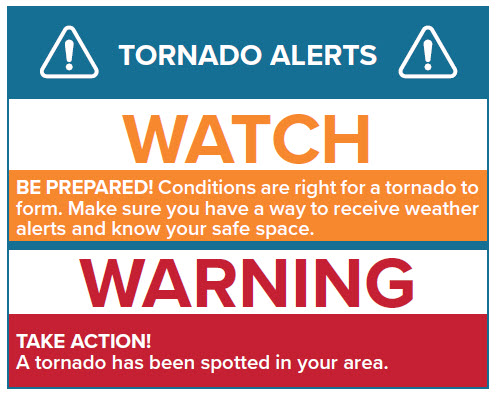Severe Weather
The UNF Emergency Management Teams work closely with the National Weather Service to monitor and react appropriately when severe weather approaches our area.
University Communications
In the event of severe weather approaching the First Coast, University officials will communicate with students, faculty and staff through multiple outlets, including email, voice message, text, social media and the Safe Ospreys app.
Additional communication outlets include desktop/computer notifications, indoor/outdoor public address systems and electronic displays on campus when deemed necessary.
What is Severe Weather?
TROPICAL STORM AND HURRICANE
The UNF Emergency Management Teams work closely with the National Weather Service to monitor and react appropriately in the event a tropical system approaches our area.
Tropical Storm Preparedness Guide
- Hurricane Season: June-November
- Tropical Storm: An organized system of strong thunderstorms with a defined circulation and maximum sustained winds of 39 to 73 mph.
- Hurricane: An intense tropical weather system with a well-defined circulation and maximum sustained winds of 74 mph or higher.
THUNDERSTORMS AND LIGHTNING
Thunderstorms can develop in Duval County anytime, but they are most frequent in late spring through early fall. All thunderstorms produce lightning. According to the Centers for Disease Control, Florida is considered the “lightning capital” of the country, with more than 2,000 lightning-related injuries occurring within the state over the last 50 years. If you hear thunder, lightning is close enough to strike.
During a thunderstorm, you should take the following precautions:
- Go inside or seek shelter immediately
- Avoid objects that conduct electricity
- Get as far away from water as possible
- Avoid open areas and high ground
TORNADOES
 A tornado is a column of violently rotating air that extends from a thunderstorm to the ground. Lightning and hail are common in thunderstorms that produce tornadoes. The extent of destruction caused by a tornado depends on its intensity, size, path, and amount of time it is on the ground. When conditions are right for a tornado, there are a few things you can do to protect yourself and your loved ones:
A tornado is a column of violently rotating air that extends from a thunderstorm to the ground. Lightning and hail are common in thunderstorms that produce tornadoes. The extent of destruction caused by a tornado depends on its intensity, size, path, and amount of time it is on the ground. When conditions are right for a tornado, there are a few things you can do to protect yourself and your loved ones:
- Ensure you have multiple ways to receive weather alerts, warnings, and notifications.
- Stay tuned to local weather or listen to your NOAA weather radio.
- Go to the innermost hallway on the lowest floor of your home or workplace. Stay away from windows.
- Do not try to outrun a tornado in a car. Seek sturdy shelter immediately.
- If you live in a manufactured home, seek other sturdy shelter immediately.
- Do not leave your shelter until the danger has passed.
- Tornado watch: BE PREPARED! Conditions are right for a tornado to form. Make sure you have a way to receive weather alerts and know your safe space.
- Tornado warning: TAKE ACTION! A tornado has been spotted in your area.
What can you do to prepare?
- Have a NOAA All-Hazards Weather Radio and battery backup to receive important weather and other emergency-related warnings.
- Make sure your phone number is current & updated with the Safe Ospreys app!
- The Emergency Alert System (EAS) and National Oceanic and Atmospheric Administration (NOAA) Weather Radio also provide emergency alerts.
- Check the weather forecast before leaving for extended periods outdoors and watch for signs of approaching storms while outside. Postpone outdoor activities if storms are imminent.
- Consider buying surge protectors, or lightning protection systems to protect your home, appliances, and electronic devices.
- Trim any trees that could be in danger of falling on your home
If Severe Weather Warning is Issued
- When thunder roars, go indoors! - When you receive a Severe Thunderstorm Warning or hear thunder, seek shelter immediately in the nearest well-constructed building. Structures such as trailers, mobile homes, or sheds are not considered well-constructed buildings. A well-constructed building is the safest place to be during a thunderstorm.
- If you are outside and cannot get to a well-constructed building, Seek shelter in a car with a metal top and sides. Do not touch anything metal and avoid touching your eyes, nose or mouth.
- If boating or swimming, get to land immediately and find a sturdy, well-constructed and grounded building or vehicle immediately.
- Pay attention to weather reports and the Safe Ospreys notification system if a Severe Thunderstorm Warning is issued for UNF.
- If indoors, avoid running water or using a landline phone. Electricity can travel through plumbing and phone lines.
- Secure outdoor furniture and other outdoor items that could potentially become flying debris.
- Avoid flooded roadways. Turn around. Don't Drown! Just six inches of fast-moving water can knock you down and one foot of moving water can sweep your vehicle away.
Additional Resources
- American Red Cross - North Florida Region
- City of Jacksonville Emergency Preparedness Guide
- Florida Department of Health
- Florida Department of Law Enforcement
- Florida Division of Emergency Management
- Florida Fire Weather Information
- Florida Highway Patrol
- Jacksonville Emergency Preparedness
- National Weather Service
- NOAA - National Oceanic and Atmospheric Administration
- Ready.gov Hurricane Information and Resources
